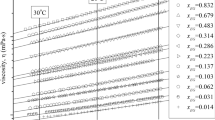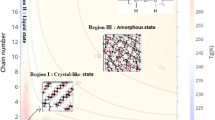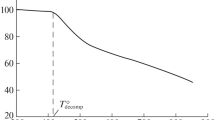Abstract
The change in free energy of activation (\(\Delta G_{\tau }^{*}\)), enthalpy of activation (\(\Delta H_{\tau }^{*}\)), and entropy of activation (\(\Delta S_{\tau }^{*}\)) of poly(ethylene glycol) with average molecular mass 400 Dalton (PEG 400) in dilute solutions of benzene have estimated based on the theory of Eyring rate process. These thermodynamic parameters have been determined using most probable dielectric relaxation times (τ) at different temperatures using Higasi method. Based on the results, the behavior of the stated polymer in non-polar solvent is discussed. The obtained results are compared with those determined using Whiffen and Thompson model.





Similar content being viewed by others
References
Mashimo S (1976) Dielectric study of chain motion of poly(p-chlorostyrene) in dilute solution. Macromolecules 9:91–97
Sengwa RJ, Kour K, Choudhary R (2000) Dielectric properties of low molecular weight poly(ethylene glycols). Polyr Int 49:599–608
Sengwa RJ (1998) Microwave dielectric relaxation in binary mixtures of Poly (ethylene glycols) in solutions. Polyr Int (UK) 45:202–206
Subramanian SK, McKenna GB (2010) A dielectric study of Poly(vinyl acetate) using a pulse probe technique. J Therm Anal Calorim 102:477–484
Sengwa RJ (2003) Microwave dielectric relaxation and molecular dynamics in binary mixtures of Poly (vinyl pyrrolidone-poly (ethylene glycol)s in non-polar solvent. Polymer Int (U.K) 52:1462–1467
Danch AL (2009) Dynamics of polymeric systems: Empirical formula of temperature dependence of relaxation time. Journal of Thermal Analysis and Calorimetry 98:601–607
El-naggara Y,urkyb G. (2001) Dielectric and chromatographic characterization of polyethylene glycols as stationary phases, Int J Polym Mater. 50:129–140. http://www.informaworld.com/smpp/title~db=all~content=t713647664~tab=issueslist~branches=50-v50
Vasheghani B, Rajabi FH, Ahmadi MH (2003) Influence of solvent on thermodynamic parameters and stability of some multicomponent polymer complexes involving an acrylic polymer, poly (ethylene imine) and poly (vinyl pyrrolidone)”. Polym Bull 58:553–563. doi:10.1007/s00289-006-0693-1
Sengwa RJ, Choudhary R (2001) Microwave dielectric relaxation and molecular dynamics in binary mixtures of poly (propylene glycol) 2000 and Poly (ethylene glycols) of varying molecular weight in dilute solution. Polym Int (U.K) 50:433–441
Dutta K, Sit SK, Acharyya S (2003) Relaxation phenomena of polar non-polar liquid mixtures under low and high frequency electric field. Pramana 61:759–772
Chitoku K, Higasi K (1966) Dielectric relaxation and molecular structure. iii. relaxation times of aniline derivatives in benzene and dioxane. Bull chem Soc Japan 39:2160–2168
Rangra VR, Sharm DR (2004) Dielectric relaxation of binary mixtures. Indian J Pure Appl Phys 42:921–925
Heston WM, Franklin AD, Hennely EJ, Smyth CP (1950) Microwave absorption and molecular structure in liquids. V. Measurement of the dielectric constant and loss of low-loss solutions. J Am Chem Soc 72:3443–3447
Eyring H (1941) Theory of rate processes. Mc Graw-Hill Book Co. Inc, New York
Roberts S, Von-Hippel A (1946) A new method for measuring dielectric constant and loss in the range of centimeter waves”. J App Phys 17:610–616
Dakins TW, Works CN, Boggs PW (1944) A resonant-cavity method for measuring dielectric properties at ultrahigh frequencies. Trans AIEE (American Institute of Electrical engineers) 63:1092–1098
Dakins TW, Works CN (1947) Microwave dielectric measurements. J App Phys 18:789–796
Smyth CP (1955) Dielectric behavior and structure. Mc-Graw Hill, New York
Madhu-Mohan T, Sreehari-Satry S, Murthy VRK (2010) Microwave dielectric relaxation, thermodynamic and confirmation studies of hydrogen bonded binary mixtures of propan-1-01 with methyl benzoate and ethyl benzoate. Indian J pure appl phys 48:668–675
Hosamani MT, Ayachit NH (2012) Activation energy ∆G * τ enthalpy ∆H * τ and entropy ∆S * τ of some indoles and certain of their binary mixtures”. J Therm Anal Calorim 107:1301–1306
Yamaguchi N, Sato M (2009) Dipole moment of poly(ethylene oxide) in solution and its dependence on molecular weight and temperature”. Polym J 41:588–594
Fattepur RH, Fattepur KH, Ayachit NH (2009) Estimation of entropy and enthalpy of a nematic liquid crystal using time domain reflectometry studies. J Therm Anal Calorim 98:601–607
Sannaningannavar FM, Ayachit NH, Deshpande DK (2006) On the effect of temperature on dielectric relaxation time of some phenols and certain of their binary mixtures”. J Mol Liq 124:124–126
Vasan ST, Ayachit NH, Deshpande DK (2006) On the effect of temperature on dielectric relaxation time of some benzene derivatives and certain of their binary mixtures. Phys Chem Liq 44:513–519
Sannaningannavar FM (1991) “Studies of some physical properties of certain organic compounds,”Ph D Thesis In physics, Karnatak University, Dharwad, Karnataka, India
Sannaningannavar FM, Navati BS, Ayachit NH (2012) Temperature dependence studies on dielectric relaxation and electric dipole moment of poly (ethylene glycol). J Macromol Sci Part B Phys. 51:393–401
Sannaningannavar FM, Navati BS, Ayachit NH (2012) Thermodynamic parameters of poly(ethylene glycol) from dielectric relaxation studies. J Appl Polym Sci 126:375–379
Higasi K (1966) Bull Chem Soc Japan 39:2157
Higasi K, Koga Y, Nakamura MK (1971) Bull Chem Soc Japan 44:988
Kumar S, Periyasamy P, Jeevanandham P (2011) Dielectric relaxation studies of binary liquid mixture of a few glycols with 1, 4-Dioxane. Int J Chem Tech Res 3:369–375
Debye P (1929) Polar molecules. Chemical Catalog Co, New York, p 90
GopalaKrishna KV (1957) A method of determining the dipole moment and relaxation time from microwave measurements. Trans Farad Soc 53:767
Cole KS, Cole RH (1941) Dispersion and absorption in dielectrics - I alternating current characteristics. J Chem Phys 9:341
Calderwood H, (1997) McGraw-Hill Encyclopaedia of Science and Technology, pp. 249–253 :Permittivity, McGraw-Hill
Havriliak S, Negami S (1967) A complex plane representation of dielectric and mechanical relaxation processes in some polymers. Polymer 8:161–190
Sengwa RJ (2003) A comparative dielectric ethylene glycol and propylene glycol at different temperatures. J Mol Liq 108:47
Whiffen DH, Thompson HW (1946) Measurements on the absorption of microwaves. Trans Farad Soc 42A:A114
Sengwa RJ (2003) A comparative dielectric ethylene glycol and propylene glycol at different temperatures. J Mol Liq 108:47
Pochylski M, Aliotta F, Błaszczak ZJ, Gapin J (2005) ´ Structural relaxation processes in polyethylene glycol/ccl4 solutions by brillouin scattering. J Phys Chem B 109:4181
Sannaningannavar FM, Patil SN, Navati BS, Melavanki RM, Ayachit NH (2013) Studies on thermodynamic properties of pure poly(ethylene glycol)-400 in the temperature range 299–363 K using volume expansivities. Polym Bull 70:3171
Sannaningannavar FM, Patil SN, Navati BS, Melavanki RM, Ayachit NH (2014) Thermodynamic parameters of dilute solutions of a polymer in benzene at varying temperatures and concentrations. J Therm Anal Calorim 115:1813
Acknowledgments
The authors acknowledge the financial help from UGC, New Delhi and their respective colleges.
Author information
Authors and Affiliations
Corresponding author
Rights and permissions
About this article
Cite this article
Sannaningannavar, F.M., Navati, B.S. & Ayachit, N.H. Activation energy (ΔG*), enthalpy (ΔH*), and entropy (ΔS*) of poly(ethylene glycol) using Higasi method. Polym. Bull. 73, 1689–1700 (2016). https://doi.org/10.1007/s00289-015-1571-5
Received:
Revised:
Accepted:
Published:
Issue Date:
DOI: https://doi.org/10.1007/s00289-015-1571-5




